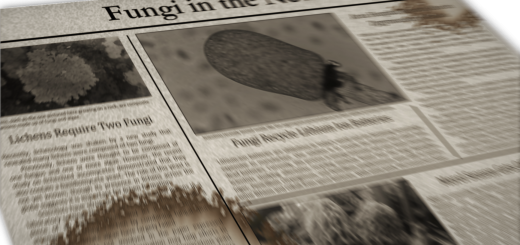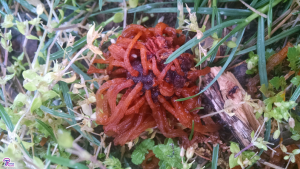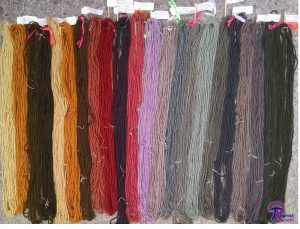#063: Overview of Lichens, Part 2: Ecology and Impact
Because of their resilient nature, lichens are able to grow in almost any climate. Their primary environmental role is initial soil creation, but they also provide food and shelter for animals and are used in a variety of ways by humans. In case you missed last week, here is a recap. Lichens are composite organisms that contain a few different species living in a mutualistic relationship. All lichens contain a mycobiont (a fungus) and a photobiont (a green alga and/or a cyanobacerium). The mycobiont provides structure while the photobiont provides sugar through photosynthesis.
In order to grow, lichens need sunlight, air, water, and a substrate. The photobiont produces energy for the lichen through photosynthesis, which uses sunlight and carbon dioxide to produce sugars. If cyanobacteria are present, the lichen can also extract nitrogen from the air through a process known as nitrogen fixation. Although lichens need water to grow, they are adept at going for long periods without water. During times of drought or of other harsh conditions, the lichen shuts down photosynthesis and other cellular processes. This makes lichens grow very slowly, but allows them to survive in almost any terrestrial environment. Lichens live in tundras, deserts, mountains, temperate zones, tropical areas, etc. and can be found on every single continent, including Antarctica! You often find lichens growing alongside moss because the moss retains water that the lichen can use to extend its growing time. Dehydrated lichens take on a rigid and brittle texture, but they become pliant and sometimes even gelatinous when water is available. The final thing lichens need is a substrate. Lichens require very few nutrients from their substrate, so they can be found growing on any stable surface. This includes rocks, tree trunks, buildings, fabric, or even sand dunes.
One of the primary roles for lichens in the environment is as a pioneer species. Their ability to colonize inhospitable substrates means that they are often the first species to return to natural disaster areas (for example, after a volcanic eruption). Lichens help create soil in these environments in two ways. First, they are able to slowly wear down rocks to create dirt. Second, they bring carbon into the environment as they photosynthesize and grow. When the lichens die, their carbon mixes with the dirt to make a rudimentary soil. This allows other species like mosses and liverworts to enter the ecosystem and help build up the soil. On sand dunes and similar substrates, lichens help form crusts that stabilize the soil and allow other organisms to live in these harsh environments. Lichens also provide food for a variety of animals. In the tundra, caribou and reindeer rely on lichens for as much as 90% of their diet during the winter months. Northern flying squirrels, mountain goats, Yunnan snub-nosed monkeys, and some insects also feed on lichens regularly (and sometimes almost entirely). Many bird species as well as northern flying squirrels use lichens in their nest construction, with some species building their nests entirely from lichens. Small animals can also use lichens for shelter. Many insects mimic the look of lichen for camouflage and small animals can even seek refuge in the larger lichens.
Humans have also used lichens in a variety of ways over the years. Some Native American tribes were known to eat lichen during times of famine and lichen can still be eaten today. However, many lichens produce compounds designed to prevent them from being eaten by animals or decomposed by bacteria. Because of this, many lichens are poisonous and cannot be eaten. Some of the poisonous lichens have historically been used as poisons for wolves or on arrowheads. Some lichen compounds have also been used for their healing properties. These are still being investigated today and lichen-derived molecules can be found in a number of commercial products like toothpastes, deodorants, salves, and even perfumes. Various lichens have also been used for dying fabrics. You might not expect it, but you can get a variety of colors from lichens, depending on the species and preparation. Today, the aesthetic value of lichens is primarily used by model makers. Lichens are used as substitutes for trees in architectural models as well as in model train scenes. Environmental scientists often use lichens as indicators of pollution. Their need for fresh air coupled with growth habit make them sensitive to airborne pollutants. The more lichens there are, the cleaner the air is. Geologists occasionally use very slow-growing lichens to determine the age of rock slides, glacier retreats, or other relatively recent geological formations.
See Further:
http://www.fs.fed.us/wildflowers/beauty/lichens/
http://www.earthlife.net/lichens/intro.html#2
http://www.ucmp.berkeley.edu/fungi/lichens/lichens.html








![#011: Characteristics of Kingdom Fungi [Archived]](https://www.fungusfactfriday.com/wp-content/themes/hueman/assets/front/img/thumb-small-empty.png)



1 Response
[…] and produce sugars for the fungi.2 For more on general lichen biology, see FFF#062 and FFF#063. The Reindeer Lichen fungi can pair with a variety of algal species to successfully form a lichen. […]